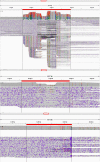Characterization of a P1-bacteriophage-like plasmid (phage-plasmid) harbouring bla CTX-M-15 in Salmonella enterica serovar Typhi
- PMID: 36748517
- PMCID: PMC9837566
- DOI: 10.1099/mgen.0.000913
Characterization of a P1-bacteriophage-like plasmid (phage-plasmid) harbouring bla CTX-M-15 in Salmonella enterica serovar Typhi
Abstract
Antimicrobial-resistance (AMR) genes can be transferred between microbial cells via horizontal gene transfer (HGT), which involves mobile and integrative elements such as plasmids, bacteriophages, transposons, integrons and pathogenicity islands. Bacteriophages are found in abundance in the microbial world, but their role in virulence and AMR has not fully been elucidated in the Enterobacterales. With short-read sequencing paving the way to systematic high-throughput AMR gene detection, long-read sequencing technologies now enable us to establish how such genes are structurally connected into meaningful genomic units, raising questions about how they might cooperate to achieve their biological function. Here, we describe a novel ~98 kbp circular P1-bacteriophage-like plasmid termed ph681355 isolated from a clinical Salmonella enterica serovar Typhi isolate. It carries bla CTX-M-15, an IncY plasmid replicon (repY gene) and the ISEcP1 mobile element and is, to our knowledge, the first reported P1-bacteriophage-like plasmid (phage-plasmid) in S. enterica Typhi. We compared ph681355 to two previously described phage-plasmids, pSJ46 from S. enterica serovar Indiana and pMCR-1-P3 from Escherichia coli, and found high nucleotide similarity across the backbone. However, we saw low ph681355 backbone similarity to plasmid p60006 associated with the extensively drug-resistant S. enterica Typhi outbreak isolate in Pakistan, providing evidence of an alternative route for bla CTX-M-15 transmission. Our discovery highlights the importance of utilizing long-read sequencing in interrogating bacterial genomic architecture to fully understand AMR mechanisms and their clinical relevance. It also raises questions regarding how widespread bacteriophage-mediated HGT might be, suggesting that the resulting genomic plasticity might be higher than previously thought.
Keywords: Illumina; Nanopore; Salmonella enterica serovar Typhi; bacteriophage; phage-plasmid; plasmid.
Conflict of interest statement
The authors declare there are no conflicts of interest.
Figures


References
-
- Klemm EJ, Shakoor S, Page AJ, Qamar FN, Judge K, et al. Emergence of an extensively drug-resistant Salmonella enterica serovar Typhi clone harboring a promiscuous plasmid encoding resistance to fluoroquinolones and third-generation cephalosporins. mBio. 2018;9:e00105-18. doi: 10.1128/mBio.00105-18. - DOI - PMC - PubMed
-
- Nair S, Chattaway M, Langridge GC, Gentle A, Day M, et al. ESBL-producing strains isolated from imported cases of enteric fever in England and Wales reveal multiple chromosomal integrations of blaCTX-M-15 in XDR Salmonella Typhi. J Antimicrob Chemother. 2021;76:1459–1466. doi: 10.1093/jac/dkab049. - DOI - PubMed
-
- Nizamuddin S, Ching C, Kamal R, Zaman MH, Sultan F. Continued outbreak of ceftriaxone-resistant Salmonella enterica serotype Typhi across Pakistan and assessment of knowledge and practices among healthcare workers. Am J Trop Med Hyg. 2021;104:1265–1270. doi: 10.4269/ajtmh.20-0783. - DOI - PMC - PubMed
Publication types
MeSH terms
Substances
Grants and funding
LinkOut - more resources
Full Text Sources

